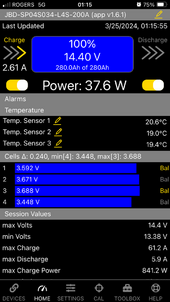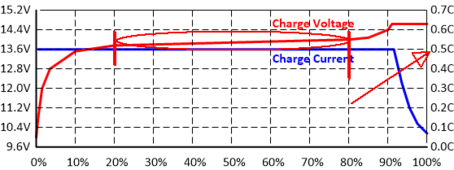wattmatters
Solar Wizard
OK, not too bad. Cell imbalance 170 mV. With regular recharging and absorption time that Cell ∆ should reduce.That’s about an hour ago after charging I still haven’t put a load on it yet. It’s just chilling.
OK, not too bad. Cell imbalance 170 mV. With regular recharging and absorption time that Cell ∆ should reduce.That’s about an hour ago after charging I still haven’t put a load on it yet. It’s just chilling.
Took me a bit too!I just figured out how you guys are replying with those orange boxes. Sorry I wasn’t able to figure that out sooner.
Speaking of recharging, what are my best day-to-day practises for that? Let it go down how far and charge back up to what?OK, not too bad. Cell imbalance 170 mV. With regular recharging and absorption time that Cell ∆ should reduce.
As mentioned previously, before sending a string of rapid fire posts, it will help everyone if you take a little time to consolidate your messages and think about what you actually need to communicate in one go, rather than hit us with a stream of consciousness.I just figured out how you guys are replying with those orange boxes. Sorry I wasn’t able to figure that out sooner.
CopyAs mentioned previously, before sending a string of rapid fire posts, it will help everyone if you take a little time to consolidate your messages and think about what you actually need to communicate in one go, rather than hit us with a stream of consciousness.
This is not about dampening your enthusiasm, it's about how you can help us to help you. If you send a barrage of messages, people will quickly lose interest in helping.
If this is your first online forum, then over time you'll learn forum etiquette and how to engage constructively. There are a lot of people here more than willing to help out, but remember their time is valuable and so making it easier for them to read and respond to your questions helps everyone, especially you.
Speaking of recharging, what are my best day-to-day practises for that? Let it go down how far and charge back up to what?
For example, this should have been one post. Stop and think for a while before hitting the Post button.My understanding is 30% to 80%
Yes.Can I load this up now with about 200 W it’s getting cold in here.
For example, this should have been one post. Stop and think for a while before hitting the Post button.
The answer to your question is "it depends".
Since I do not know enough about your set up, use case and requirements, I cannot say.
If the system is going to be discharged daily, then recharge it to 100%. I would only not charge to 100% if the battery was going to be left for a long time without discharging it.
Then the question becomes how often is a recharge required?
If the system is a backup power source then charge every day after a discharge. That ensures maximum reserve capacity is available should it be required.
If it's not required as back up power source then it depends on how much energy is consumed during each discharge or each day.
But to provide some margin for error, do a full charge at some point when the battery is below 50% and above 10%. When exactly is up to you.
If you typically consume 10% of the battery per day, then you might only need to fully recharge it every 5-7 days.
If you typically consume 20% then perhaps every 2-4 days.
Or you could just decide to fully charge once it falls below 40% (or 50% or 30%). Up to you.
Ask the question - if I don't recharge now, will it make it through the next discharge session? Then add a safety buffer.
It won't hurt the battery. Used this way it will last for many
very awesome thank youFor example, this should have been one post. Stop and think for a while before hitting the Post button.
The answer to your question is "it depends".
Since I do not know enough about your set up, use case and requirements, I cannot say.
If the system is going to be discharged daily, then recharge it to 100%. I would only not charge to 100% if the battery was going to be left for a long time without discharging it.
Then the question becomes how often is a recharge required?
If the system is a backup power source then charge every day after a discharge. That ensures maximum reserve capacity is available should it be required.
If it's not required as back up power source then it depends on how much energy is consumed during each discharge or each day.
But to provide some margin for error, do a full charge at some point when the battery is below 50% and above 10%. When exactly is up to you.
If you typically consume 10% of the battery per day, then you might only need to fully recharge it every 5-7 days.
If you typically consume 20% then perhaps every 2-4 days.
Or you could just decide to fully charge once it falls below 40% (or 50% or 30%). Up to you.
Ask the question - if I don't recharge now, will it make it through the next discharge session? Then add a safety buffer.
It won't hurt the battery. Used this way it will last for many thousands of cycles.
Yes and no, It needs many hours at a high state of charge to balance the cells. Weather this is done now or later doesnt really matter, so yes yu can use it but you need to balance the cells some time. It will only help you. The battery doesnt care....Balancing the cells allows you to use more of the battery.Can I load this up now with about 200 W it’s getting cold in here.
Yes.
200 W will draw about 15-17 A from the battery, give or take. If the battery is fully charged then it would last for several days at that rate.

No, I don’t have the confidence in making any changes to the BMS thinking all I would do is screw something up, possibly affect my warranty as “they” set it themselves apparently…View attachment 204741
This battery is somewhat imbalanced. You MAY be losing a very small % of total capacity; however your minimum cell is at 3.45V @ 2.61A (0.01C).
Did you make the changes to the balance settings?
Balance at 3400?
Turn OFF "Bal only when charging"?
Given that it's charging some cells while above 3650mV, this suggests you did not make all the changes I recommended. You must make the changes and then write them to the BMS. Yes, if your cell voltages are below the "full" voltage, the BMS may make a voltage-based guess when settings are uploaded.
Lastly, there is no reason to wait to discharge a battery after you have reached true 100%. When you see that you are > 14.2V and current has dropped to below 7A, you can be confident that you are close enough to 100% to not matter. There are diminishing returns running a generator to charge at low rates.
View attachment 204741
This battery is somewhat imbalanced. You MAY be losing a very small % of total capacity; however your minimum cell is at 3.45V @ 2.61A (0.01C).
Did you make the changes to the balance settings?
Balance at 3400?
Turn OFF "Bal only when charging"?
Given that it's charging some cells while above 3650mV, this suggests you did not make all the changes I recommended. You must make the changes and then write them to the BMS. Yes, if your cell voltages are below the "full" voltage, the BMS may make a voltage-based guess when settings are uploaded.
Lastly, there is no reason to wait to discharge a battery after you have reached true 100%. When you see that you are > 14.2V and current has dropped to below 7A, you can be confident that you are close enough to 100% to not matter. There are diminishing returns running a generator to charge at low rates.
No, I don’t have the confidence in making any changes to the BMS thinking all I would do is screw something up, possibly affect my warranty as “they” set it themselves apparently…
However, as I was saying, when I woke up this morning, those cells were completely balanced to the thousand decimal place.
As in every day since I’ve had it.
As in prior pics I sent show…
And after every time I’ve ever charged it, they always balance out completely on their own.
It would be unusual for them to be more than .003 out.
if we’re talking about the same thing.

OK there’s a lot there but I’ll just say for the moment that no I have never made any changes to this battery. I just got the app yesterday that would’ve allowed me to do that and I told the person that I didn’t think I even wanted to use it because I thought I might accidentally hit something…The settings I recommend are actually more conservative and would better protect the battery, plus, I was under the impressions that you had overwritten the settings with the defaults.
Voltage only represents balance when the battery is nearly charged or nearly empty. In the 3.10-3.40V operating range of the battery, there is rarely a significant deviation in voltage, and it does NOT represent "balance."
In other words, when under load and below 3.40V, if your voltages aren't pretty tight, you have BIG problems, but imbalanced batteries will still exhibit tight voltages in the operating range.
No. They bled off surface charge.
We aren't. Voltage is not balance UNLESS you're nearly fully charged or nearly empty.
Please refer to this image for the CONCEPT. Do not take the numbers literally:
View attachment 204748
Note that the arrow indicates this is for charging at 0.5C. That would be if you charged at 140A.
I have circled the area in between the two vertical lines roughly corresponding to 20 and 80% (these are approximate. Do not store these values in your head as significant). As you can see, the red curve is nearly flat inside the circled area. OUTSIDE the circled area, the voltages changes much more rapidly than it does in the operating range.
Again, do not take these numbers literally or use this image for ANYTHING besides understanding that throughout the vast majority of the operating range, the voltage of the battery and cells change very little.


